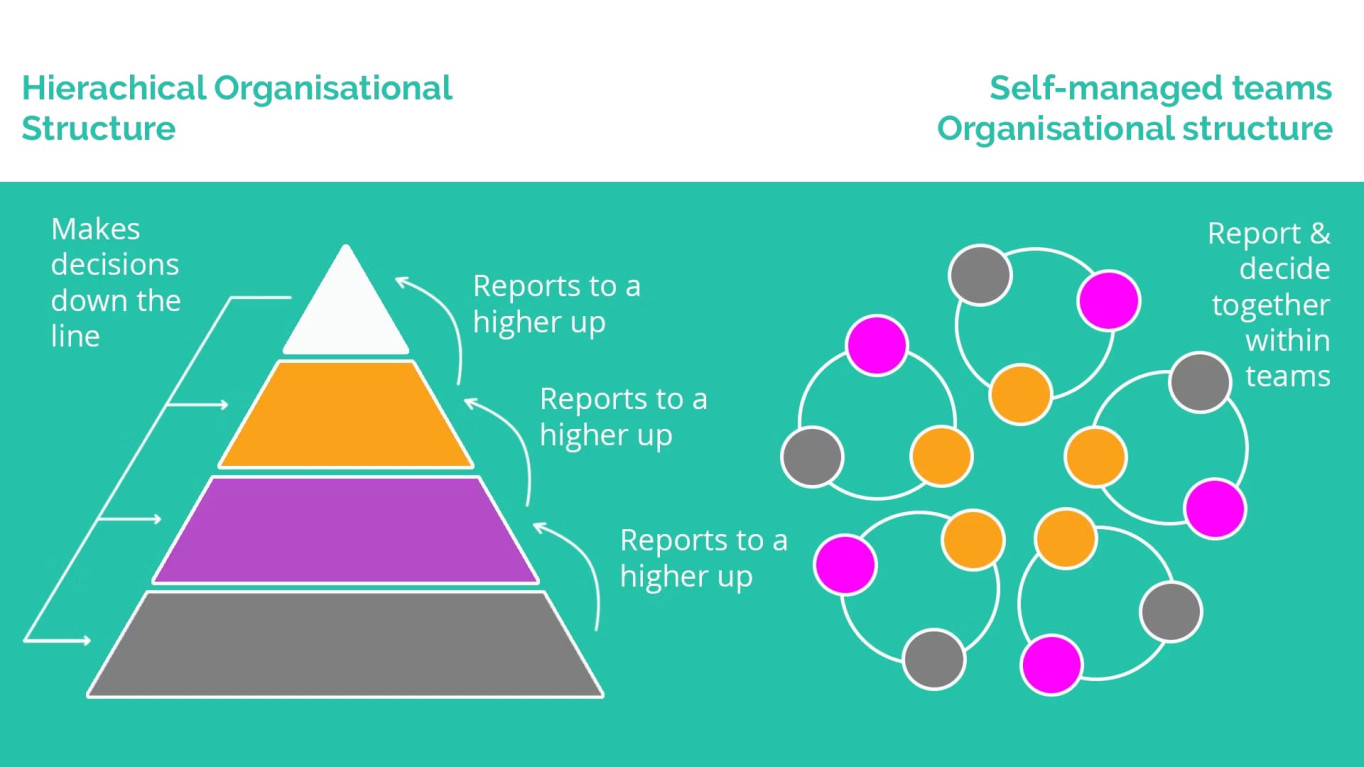- Understanding the Concept of a Self-Managing Team
- Identifying the Right Employees for a Self-Managing Structure
- How to Cultivate a Culture of Trust and Autonomy
- Empowering Employees to Make Decisions Independently
- Setting Clear Goals and Expectations for Your Team
- Monitoring Progress Without Micromanaging
- Summary
Creating a self-managing team can transform the way your business operates. By empowering employees to take ownership of their work, you foster a culture of trust and autonomy that drives productivity and innovation.
However, transitioning to this model requires careful planning, the right team members, and a strong framework to ensure success. In this guide, we’ll explore the key steps to building a self-managing team, from selecting the right people to establishing clear goals and supporting ongoing growth.
Understanding the Concept of a Self-Managing Team
Understanding the concept of a self-managing team is key to unlocking your team's full potential. A self-managing team operates with a high degree of autonomy, taking ownership of their tasks and decisions. Embracing this approach can lead to increased motivation, creativity, and efficiency within your team.
What Defines a Self-Managing Team?
A self-managing team is characterized by its autonomy and collective responsibility. Unlike traditional teams where leadership is hierarchical, self-managing teams operate with a decentralized structure, allowing team members to make decisions and manage their work independently. These teams thrive on mutual trust, collaboration, and shared goals, which enable them to function effectively without constant oversight. The empowerment of individual team members is key to the success of self-managing teams, as it fosters a sense of ownership and accountability.
In a self-managing team, decisions are often made collaboratively, and responsibilities are distributed based on expertise rather than seniority. This approach not only enhances efficiency but also encourages creativity and innovation. The flexibility of self-managing teams allows them to adapt quickly to changes, making them particularly effective in dynamic environments.

Key Characteristics of Successful Self-Managing Teams
Successful self-managing teams share certain key characteristics that enable them to function effectively and achieve their goals. These teams are distinguished by their ability to operate autonomously while maintaining strong cohesion and alignment with their objectives. They demonstrate a high level of adaptability and resilience, which is crucial in navigating challenges and seizing opportunities.
- Strong Communication: Open and continuous communication is vital for aligning team efforts and resolving issues quickly.
- Clear Goals: Every member understands and aligns with the team’s objectives, ensuring that everyone is working towards the same outcomes.
- Trust and Respect: Team members trust each other to fulfill their roles and respect each other's contributions and perspectives.
- Adaptability: The team can quickly adjust to changes and challenges, demonstrating flexibility in their approach.
- Shared Leadership: Leadership responsibilities are distributed among the team, allowing individuals to step up when their expertise is needed.
Benefits of Adopting a Self-Managing Team Structure
Implementing a self-managing team structure offers numerous advantages for both the organization and its employees. It fosters a culture of accountability and empowers employees, leading to higher engagement and satisfaction. Additionally, it allows for quicker decision-making and problem-solving, as team members are equipped to address challenges independently.
Moreover, self-managing teams can enhance innovation and creativity, as they are not constrained by rigid hierarchies. This freedom enables them to explore new ideas and approaches, driving continuous improvement. Finally, the increased flexibility and adaptability of self-managing teams make them well-suited to thrive in fast-paced, ever-changing environments.
Identifying the Right Employees for a Self-Managing Structure
Selecting the right employees is crucial for the success of a self-managing team. Not every employee is suited for the level of autonomy and responsibility that this structure requires, so it's important to carefully assess who will thrive in this environment. Look for individuals who are self-motivated, accountable, and capable of making decisions independently. These traits are essential for ensuring that the team can function effectively without constant supervision.

Traits to Look for in Potential Self-Managing Employees
When identifying candidates for a self-managing team, look for these essential traits. Individuals with these qualities are more likely to succeed in a self-managing environment, as they are capable of handling the autonomy and responsibility that comes with it.
- Self-Motivation: They take initiative without needing constant supervision, driving their own work forward.
- Accountability: They own their tasks and outcomes, showing responsibility for their work and its impact on the team.
- Problem-Solving Skills: They can navigate challenges independently, finding solutions without always needing guidance.
- Communication: They communicate effectively with the team, ensuring that everyone stays informed and aligned.
- Adaptability: They can adjust to changes and new responsibilities, remaining flexible in dynamic situations.
How to Assess Team Members for Self-Management Readiness
Assessing whether a team member is ready for self-management requires careful observation and evaluation. Start by reviewing their past performance, focusing on instances where they demonstrated initiative and handled responsibilities independently. These examples can indicate their readiness for a self-managing role and their ability to thrive in such an environment.
Additionally, consider conducting informal interviews or surveys to gauge their comfort level with autonomy. Ask questions that explore how they handle responsibility, decision-making, and collaboration without direct supervision. Their responses can provide valuable insights into their suitability for a self-managing structure, helping you identify those who are likely to succeed.
The Role of Personality in Self-Management Success
Personality plays a significant role in determining the success of a self-managing team member. Individuals who are naturally independent, confident, and proactive tend to be better suited for these teams. For example, someone with a high degree of self-discipline will likely excel in a role where they need to manage their time and responsibilities effectively.
On the other hand, team members who prefer structure and guidance might struggle in a self-managing environment. It’s important to balance different personalities within the team to ensure that everyone can contribute effectively, even if they approach tasks differently. This diversity can enhance the team’s overall performance by bringing various strengths to the table.
How to Cultivate a Culture of Trust and Autonomy
Building a self-managing team requires a strong foundation of trust and autonomy. Without these elements, the team will struggle to function independently and make decisions confidently. Trust fosters a sense of security, allowing team members to rely on each other and collaborate effectively. Autonomy empowers individuals to take ownership of their roles and make decisions that align with the team's goals.

To cultivate trust and autonomy, it’s essential to create an environment where open communication and transparency are encouraged. This environment enables team members to express their ideas and concerns freely, contributing to a culture of mutual respect. Furthermore, providing the necessary support and resources can help team members feel confident in their ability to manage their responsibilities independently.
The Importance of Trust in Self-Managing Teams
Trust is the cornerstone of a successful self-managing team. Without it, autonomy can lead to confusion, miscommunication, and conflict. Trust allows team members to rely on each other, knowing that everyone is committed to the team's success. It also reduces the need for constant oversight, enabling the team to operate more freely and effectively.
To build trust, it’s essential to foster open communication and transparency. Encourage team members to share their thoughts, concerns, and ideas without fear of judgment. This openness creates a supportive environment where trust can grow naturally, leading to stronger collaboration and a more cohesive team.
Strategies for Building Trust Among Team Members
Building trust within a self-managing team requires deliberate effort and consistent practices. It’s important to establish a foundation of mutual respect and open communication, as these elements are crucial for fostering trust. Here are some strategies to build trust within your team:
- Encourage Open Communication: Ensure that everyone feels heard and respected.
- Lead by Example: Demonstrate trust in your team by giving them autonomy and showing confidence in their abilities.
- Promote Team-Building Activities: Strengthen bonds through shared experiences that build camaraderie.
- Be Transparent: Share information and decisions openly, fostering a culture of honesty and trust.
- Recognize and Reward Trustworthy Behavior: Reinforce positive actions that contribute to a trustworthy team environment.
How to Promote Autonomy Without Losing Control
Promoting autonomy doesn’t mean losing control entirely; it’s about finding the right balance. Start by clearly defining the boundaries within which the team can operate independently. This includes setting clear goals, expectations, and decision-making guidelines that provide structure while allowing for flexibility.
Regular check-ins can help monitor progress without micromanaging. These meetings provide an opportunity to address any concerns, offer support, and ensure that the team remains aligned with the overall objectives. By maintaining a balance between autonomy and oversight, you can empower your team while keeping them on track.
Creating a Safe Environment for Independent Decision-Making
To foster independent decision-making, create an environment where team members feel safe to take risks and make mistakes. Encourage them to explore new ideas and approaches, even if they are unconventional. This can be achieved by:
- Encouraging Experimentation:= Allow room for trial and error, supporting innovative approaches.
- Providing Support: Be available to guide, but don’t interfere unnecessarily, giving the team space to learn.
- Celebrating Successes and Learning from Failures: Treat mistakes as learning opportunities, not as failures.
- Establishing Clear Guidelines: Define what decisions can be made autonomously to provide clarity and confidence.
Empowering Employees to Make Decisions Independently
Empowering your team to make decisions independently is key to a self-managing structure. This not only boosts their confidence but also enhances their sense of ownership and responsibility, leading to better outcomes for the team. Employees who are empowered to make decisions are more likely to be engaged, motivated, and committed to their work.

How to Train Employees for Independent Decision-Making
Training is essential for equipping employees to make decisions on their own. Start by gradually increasing their decision-making responsibilities. For example, allow them to make smaller decisions independently and provide feedback on the outcomes, helping them learn and grow. As they become more comfortable with making decisions, gradually increase the complexity of the decisions they are responsible for.
It’s also important to provide the right tools and resources. Offer training sessions, workshops, or mentoring programs that focus on decision-making skills. Encourage them to analyze situations critically, consider different perspectives, and anticipate the consequences of their decisions. This approach helps build their confidence and competence in making independent decisions.
Creating Decision-Making Frameworks for Your Team
Decision-making frameworks help guide your team’s choices while maintaining a level of autonomy. Consider these elements when developing a framework for your team:
- Define Decision-Making Boundaries: Clarify what decisions can be made independently and what requires approval.
- Establish Criteria:Set clear criteria for evaluating decisions, ensuring they align with the team’s goals and values.
- Provide Resources: Offer tools, information, and support that enable informed decision-making.
- Encourage Consultation: While autonomy is important, encourage team members to seek input when needed.
Encouraging Responsible Risk-Taking
Encourage your team to take calculated risks by creating a supportive environment where they feel comfortable stepping out of their comfort zones. Responsible risk-taking can lead to innovation and new opportunities, but it requires a culture that values learning from mistakes rather than penalizing them.

Provide guidance on how to assess risks, including weighing potential outcomes and considering the impact on the team and organization. Encourage team members to share their risk-taking experiences, both successes and failures, to promote learning and continuous improvement. By fostering a culture of responsible risk-taking, you empower your team to push boundaries and achieve greater success.
The Role of Feedback in Empowering Decision-Making
Feedback plays a critical role in empowering your team to make decisions. By providing regular, constructive feedback, you help your team members understand the impact of their decisions and how they can improve.
It’s important to create a culture where feedback is seen as a tool for growth rather than criticism. This encourages team members to take risks and learn from their experiences, ultimately leading to better decision-making.
Setting Clear Goals and Expectations for Your Team
Setting clear goals and expectations is crucial for guiding your team toward success. It ensures that everyone is aligned, understands their role, and knows what they’re working toward. With well-defined objectives, your team stays motivated, focused, and capable of achieving great results.
The Role of Transparent Communication in Goal Setting
Transparent communication is essential for setting clear goals and expectations. When team members understand the “why” behind their tasks, they’re more likely to be motivated and aligned with the team’s objectives.
Regularly share updates on company goals and how they relate to the team’s work. This keeps everyone informed and focused on the bigger picture.
How to Align Team Goals with Company Objectives
Aligning team goals with company objectives requires a clear understanding of both. Start by defining your company’s long-term vision and break it down into specific, measurable goals.
Next, work with your team to identify how their work contributes to these objectives. This not only provides clarity but also helps team members see the value of their contributions.
Using SMART Goals to Drive Team Performance
To drive exceptional team performance, it’s crucial to set goals that are not only clear but also strategically crafted. Implementing a structured approach can transform ambitions into actionable plans and ensure every team member knows exactly what success looks like. Discover how the SMART framework can revolutionize your goal-setting process and elevate your team’s productivity.
- Specific: Clearly define what you want to achieve.
- Measurable: Establish criteria for measuring progress.
- Achievable: Set realistic goals that challenge but don’t overwhelm.
- Relevant: Ensure goals align with broader company objectives.
- Time-bound: Set deadlines to create a sense of urgency.
Balancing Flexibility with Goal-Oriented Work
Balancing flexibility with goal-oriented work is key to fostering a productive and adaptable team. While flexibility allows for creativity and responsiveness, it's important to stay focused on the end goals.

By maintaining this balance, you can empower your team to innovate while still achieving the desired outcomes.
- Set Clear Priorities: Focus on the most important tasks while allowing flexibility for how they’re completed.
- Encourage Adaptability: Allow team members to adjust their approach as needed to meet changing circumstances.
- Maintain Focus: Keep the team aligned with overall goals even when adapting to new challenges.
Monitoring Progress Without Micromanaging
Monitoring progress without micromanaging is essential for building trust and empowering your team. It allows you to stay informed and provide guidance while giving your team the autonomy to take ownership of their work. Striking this balance leads to a more motivated and productive team, driving better results.
The Challenges of Balancing Oversight and Autonomy
Balancing oversight with autonomy is one of the biggest challenges in managing a self-managing team. Too much oversight can stifle creativity and reduce the benefits of self-management, while too little can lead to disorganization and missed goals.
To strike the right balance, focus on setting clear expectations and regularly reviewing progress without interfering in day-to-day operations. This allows you to maintain control without undermining the team’s autonomy.
How to Implement Effective Monitoring Techniques
Effective monitoring involves keeping track of progress without micromanaging. Use tools like project management software to monitor tasks and deadlines, and schedule regular check-ins to discuss progress and address any challenges.
- Project Management Tools: Use software to track tasks and deadlines.
- Regular Check-Ins: Schedule meetings to review progress and address challenges.
- Feedback Loops: Create opportunities for team members to share feedback on the process.
The Role of Regular Check-Ins in Maintaining Team Momentum
Regular check-ins are crucial for maintaining momentum in a self-managing team. These meetings provide an opportunity to review progress, address any issues, and adjust goals or strategies as needed.
- Set a Schedule: Regularly scheduled check-ins ensure consistency.
- Be Collaborative: Use these meetings to encourage team input and collaboration.
- Focus on Solutions: Address challenges and work together to find solutions.


 Posted on Aug 27, 2024 by Brainy HR
Posted on Aug 27, 2024 by Brainy HR


